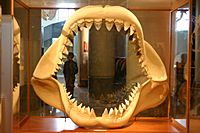Jawed vertebrates facts for kids
Quick facts for kids GnathostomataTemporal range: Ordovician - Recent
|
|
|---|---|
 |
|
| Megalodon jaws | |
| Scientific classification | |
| Kingdom: | |
| Phylum: | |
| Subphylum: | |
| Infraphylum: |
Gnathostomata
|
Gnathostomata (say "NAY-tho-STOH-mah-tah") is a big group of vertebrates. These are animals with a backbone. What makes Gnathostomata special is that they all have jaws. This group includes almost all living vertebrates today.
Long ago, people thought this group only included fish with jaws. But now we know it also includes all tetrapods. Tetrapods are animals with four limbs, like amphibians, reptiles, birds, and mammals. This is because tetrapods evolved from ancient jawed fish. Gnathostomata are the "sister group" to Agnatha. Agnatha are vertebrates that do not have jaws, like lampreys.
The first Gnathostomata appeared a very long time ago. This was during the Ordovician period. They became very common and diverse in the Devonian period. The Devonian period is sometimes called the 'Age of Fishes' because so many different fish lived then. Later, land vertebrates, which are also part of Gnathostomata, appeared in the Carboniferous period.
Contents
What Are Gnathostomata?
Gnathostomata are a major group of animals with backbones. Their most important feature is having jaws. Jaws help animals grab food, bite, and chew. This was a huge step in evolution. It allowed these animals to eat many different kinds of food. This helped them become very successful.
Types of Jawed Vertebrates
The Gnathostomata group is very large and includes many different kinds of animals. Scientists often divide them into a few main types:
Cartilaginous Fish
These are fish whose skeletons are made of cartilage, not bone. Cartilage is a flexible material, like what's in your nose or ears.
- Chondrichthyes are the cartilaginous fish. This group includes sharks, rays, and chimaeras. Sharks are well-known predators of the ocean.
Armored Fish (Extinct)
These were ancient fish that are now extinct. They had strong, bony plates covering their heads and bodies.
- Placodermi were a group of armored fish. They lived a very long time ago and are no longer around. Some of them were very large, like Dunkleosteus.
Bony Fish
Most fish you know today are bony fish. Their skeletons are made of bone.
- Osteichthyes are the bony fish. This is a huge group.
- Actinopterygii are the ray-finned fish. This means their fins are supported by bony rays. Most modern fish, like tuna and salmon, are in this group.
- Sarcopterygii are the lobe-finned fish. Their fins are fleshy and muscular, with bones inside. This group includes lungfish and coelacanths. It's also the group from which land vertebrates evolved.
Land Vertebrates
These are the animals that moved from water to land. They are all part of the Gnathostomata group because they evolved from jawed fish.
- Tetrapods are all the land vertebrates. This means "four feet."
- Amphibians are animals like frogs, toads, and salamanders. They usually live part of their lives in water and part on land.
- Amniotes are a group of tetrapods that lay eggs with a special membrane (or have live birth). This helps their young develop on land without drying out.
- Sauropsids include reptiles (like crocodiles, lizards, and snakes) and birds.
- Synapsids include mammals. Mammals are animals that have fur or hair and feed their babies milk.
Timeline of Gnathostomata
- Ordovician Period: The very first jawed vertebrates appeared.
- Devonian Period: This was a time when jawed fish became very diverse. Many new types of fish evolved. This period is often called the "Age of Fishes."
- Carboniferous Period: Land vertebrates, which are part of the Gnathostomata, first appeared and started to spread across the land.
Images for kids
See also
 In Spanish: Gnathostomata para niños
In Spanish: Gnathostomata para niños



